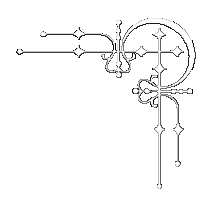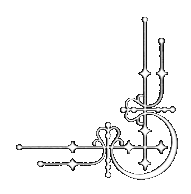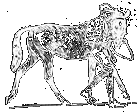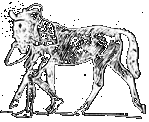Upon this site, I plan to touch upon a subject that precious few modern race horsemen seem to have a very real solid foundation in or understanding thereof. Study the above photograph well! It was typical back 50 or more years ago for a Thoroughbred man to take a very active role in how his horses were shod. They were there when the shoes came off and new ones were put on. It seems to be the modern norm to consider shoeing an afterthought, allowing the racetrack plater to have full authority on how one's racehorse will be shod. What a horrible mistake for any trainer to so dismiss the importance of how one's horse is to be shod and to know how he was previously shod! Woe to the trainer that is not present when those shoes are pulled-off and new ones are tacked on! He should be present always. I was lucky enough to have personally shod my entire stable while I was racing. True, rather time consuming, but what an advantage this was! In my younger days, I initially studied some of the best race farriers in the world, and then eventually, I started doing a little at a time until I worked my way up to actually shoeing my own horses. For whatever it may be worth, I never experienced a catastrophic breakdown or any major ligament/tendon damage in any of my horses during my career. I really do think that how one trims and plates a racehorse is a major contributing factor to soundness. Never underestimate the importance of the hoof, trimmed and plated for maximum effort and ease of motion.
The commonly observed race track hoof found on USA thoroughbred tracks will be one of a very low heel with a long toe. Terrible! I have little idea why so many race platers seem to turn out horses consistently with this configuration. It makes absolutely no sense. I can only think of two reasons. One, I have found most hooves on thoroughbreds tend to lose angle over a month of work and racing. If the farrier trims that hoof, uniformly all around, naturally, you are going to get lower and lower angles. I have observed the common race track plater to never use toe calipers (dividers), hoof angle gauges, or hoof levels in producing the finished shod animal. They seem to think that such measuring instruments are unnecessary, perhaps even a sign of an apprentice. Secondly, it is true the lower the hoof's angle, the more the horse will be stimulated to lengthen stride. This sounds good on first impression, but it is not what it is cracked up to be. If this is part of the common thinking behind the trimming for low race track hoof angles, then it is logic flawed.
One of my favorite racehorse trainers of the past, Enoch Wishard is worth studying. Mr. Wishard plied his trade in the late 1800s. He had a wide reputation in the USA of doping horses and doing well with them. He later moved his stable to England as was popular during the latter part of the 19th century with equal success on the track and doping rumors. The British Jockey Club regarded him with great suspicion as well as all other American trainers of that time. Royal Flush was one of his horses that did well and supposedly was hopped with cocaine. He won an upset in the Royal Hunt Cup at Ascot and then a few months later, the Steward's Cup at Goodwood.
Wishard gave an interview to a racing journalist in 1902 saying he had never found any hop that did any good for a horse. He elaborated: "I have heard lots of things and tried I think all of them."
Myself, as a young trainer, equally inquisitive, I could not agree more. I have done the same with the same results. There is really no such thing as a performance enhancer. As far as Wishard's alleged cocaine use in his horses, most modern observers report athletic deterioration with the use of cocaine; there is no evidence of its being a performance enhancer. The myth of the winning doping American trainer lingers and followed him and his counterparts everywhere--as does the mystique of the effectiveness of the modern "performance enhancers" even to this day. Hopping is a myth, but that is a subject for another page.
Todd Sloan, the famous jockey that popularized the modern jockey seat, writes in his 1915 book this of Enoch Wishard:
"I put down Enoch Wishard as one of the best trainers, I have ever come in close touch with. He, I believe started life as a blacksmith in a town called Wellsville, and from this town also came Duke, who at present, trains for Mr W. K. Vanderbilt and John M'Graw, the manager of the New York Baseball Club. Enoch Wishard made a study of horses' feet from early days before he took to training, and he followed this up by always caring for their mouths. These certainly are two of the greatest essentials when considering a horse's chance of progressing in training. Fortunately many trainers of the present day have given serious attention to these matters, which one must say were far too often neglected in the past. Wishard asked regularly about the mouths of his charges and he would never leave the care of their feet to anyone but himself. Perhaps more than anyone else he has proved how a man can reach the top of the trainer's calling owing to observation and taking the trouble to think about the disposition of his horses.Wishard's, by the way, is a case that helps to prove that there is very little heredity in training. Tell me any great trainer whose son has proved as great a man at the business as his father before him. The talent is supposed to "pass down," but that is sheer nonsense. I do not think there are "born trainers" any more than there are "born jockeys." Some jockeys may have taken up riding through their fathers having been at the game, but it doesn't follow for a moment that they will achieve success. Take the list of all you can, HOW HORSES WERE SHOD, ever remember: there are a few exceptions on the other side but the vast majority goes to support what I have said."
Truer words were never written on improving racehorses as quoted from the famous Todd Sloan above! If a trainer can take care of a racehorse's feet and mouth, he will have a large part of the battle won of improving any horse. Forget about hop, it is close observation of a horse's hooves and mouth that can make all the difference in the world and improve most any horse taken from most any average trainer.





















